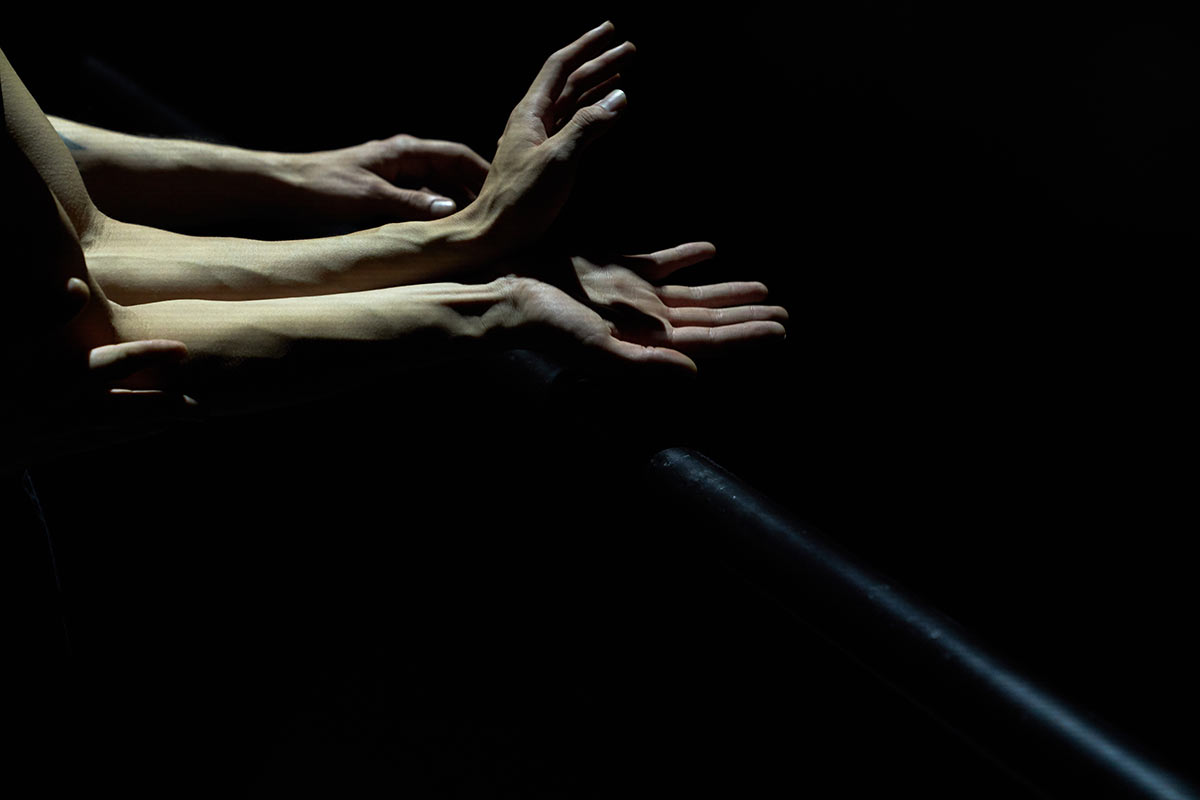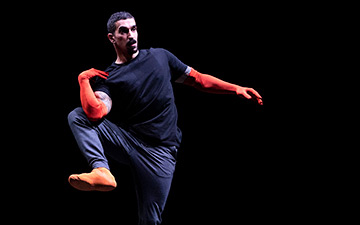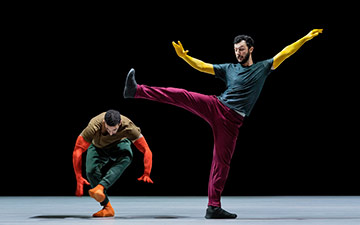
© CLI Studios/The Barre Project. (Click image for larger version)
William Forsythe, Tiler Peck and others
The Barre Project: Blake Works II
★★★★★
Filmed in Los Angeles, La Mirada Theatre
Streamed 25, 27 March 2021, reviewed from the CLI Studios video stream, available by subscription: to be screened by Sadler’s Wells in May 2021
www.williamforsythe.com
www.instagram.com/tilerpeck
clistudios.com

© Dominik Mentzos. (Click image for larger version)
The resulting performance was professionally filmed and edited by Devin Jamieson and his technical team, who are briefly visible at the end of the recording. Jamieson acted as host for the live Q&A session with Forsythe and Peck after the two initial screenings at 8pm EDT. Forsythe expressed his admiration for the filming and the lighting, by Brandon Stirling Baker, that made the La Mirada stage appear deep and mysterious, the barre at the rear a streak of silver.
The reason for the barre is given in the opening dedication ‘for all those who have sustained themselves with a barre in any form’. As dancers stuck at home know, a barre can be a chair back, kitchen unit, tabletop or bookcase shelf. In a dance studio, it serves as the support for a daily ritual, accompanied by music – a pianist or a recording. Forsythe’s choice is five tracks from albums by British composer and performer James Blake. This is the second time he has choreographed to Blake’s music: the first was a 2016 work for the Paris Opera Ballet, due to Enter English National Ballet’s repertoire in 2022.
In The Barre Project, the metal handrail is a theatrical prop rather more than a support. It defines the space for the choreography, a reference point for Forsythe’s five movement studies. The first begins with Peck swivelling back and forth alongside the barre in a swift pacing routine based on tendus – legs opening and closing in a turned-out position without leaving the floor. This is how ballet training starts, after the warm-up pliés. This is how a number of ballets by Balanchine and Forsythe start, using the basic exercise as the keynote for choreographic developments.

© CLI Studios/The Barre Project. (Click image for larger version)
Peck’s rhythm is determined by the percussive beats and distorted sounds of Blake’s Buzzard and Kestrel composition. She barely touches the barre, moving away from it for quicksilver pirouettes. Ishimoto, who follows her, makes more use of it as an aide for jumps and batterie. When he is joined by bouncy Mejia, their extended legs in tendus resemble fencers’ foils. Peck’s arrow-sharp feet give the illusion that she is en pointe, so high is her three-quarter pointe footwork in soft shoes.
Hands are then foregrounded in a reverie to Blake’s plaintive Lindisfarne, with its hesitant pauses and unintelligible falsetto lyrics. A pair of hands touches the metal barre on three levels as if playing different keyboards. Though the effect is wistful, it’s nowhere near as intriguing as Jonathan Burrows’s 1995 film Hands, with its rhythmic gestures to Matteo Fargion’s quirky music. Forsythe’s fondness for Blake’s music eludes me, in spite of his statement in a Zoom clip that his choreography demonstrates how he listens.

© CLI Studios/The Barre Project. (Click image for larger version)
The movement studies resume, with different outfits for each section. (Peck designs dancewear for a commercial firm). The choreography becomes Forsythian neo-classical, tailored for each dancer’s special qualities. Peck has an adagio solo to Blake’s woebegone Lullaby for my Insomniac in which she revels in contrasting dynamics, her upper body in contrapposto with her arching legs. Here she makes use of the barre as a passive partner, enabling her to reach away and return to it as she twists and undulates. In come the men in turn, showing off their best jumps and spins with no need of the barre. There’s a duet for Mejia and Mack in counterpoint rivalry, then another for Peck and Mack as Latin American ballroom partners, hips thrusting and grinding in sassy salsa moves. Everybody gets their virtuoso moments in the spotlight before all four combine in an exuberant finale to pulsing, clanging rhythms. Earlier rehearsal footage revealed how fiendishly fast the dancers had to count the beats in order to synchronise their seemingly spontaneous responses to Blakes’ music. As Forsythe commented: ‘Dudes, you are valiant’.
The entrancing film ends with a reprise of the hands on the barre sequence to Lindisfarne’s soulful lyrics. This time there are four hands interweaving along the barre, representing the dancers’ – everyone’s – need for touch, reassurance and support.

















You must be logged in to post a comment.